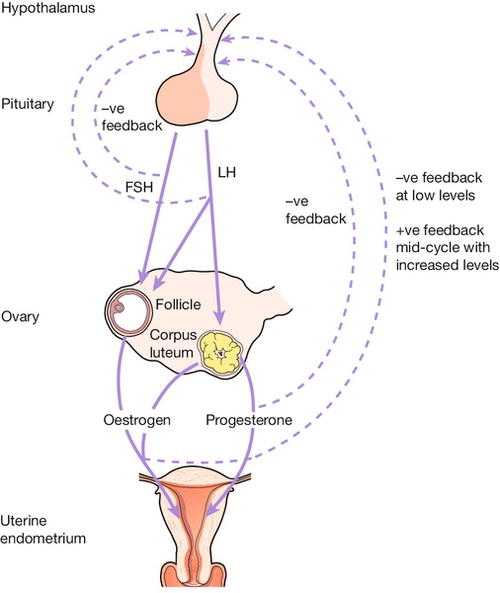7 Humans are one of the few species which have a monthly reproductive cycle. Most mammals ovulate less frequently than once a month, for example, sheep ovulate once a year and rabbits ovulate in response to coitus. In these species, insemination usually leads to pregnancy, but in normal humans, there is only a 30% chance of conception at each ovulation. The high frequency of ovulation in our species compensates for our relatively low fertility. The menstrual cycle can be described by referring to either the uterus or the ovary. The endometrial cycle results from the growth and shedding of the uterine lining – the endometrium. At the end of the menstrual phase, the endometrium thickens again – the proliferative phase. After ovulation, endometrial growth stops and the glands become more active and full of secretions – the secretory phase. These endometrial changes are controlled by the ovarian cycle. The average duration of the ovarian cycle is 28 days and it is composed of: If the cycle is prolonged, the follicular phase lengthens (longer time to ovulation) but the luteal phase remains constant at 14 days. Fundamental to the normal menstrual cycle are: Control of follicular maturation and ovulation is exercised by the hypothalamo–pituitary–ovarian axis (Fig. 7.1). The hypothalamus controls the cycle, but it can itself be influenced by higher centres in the brain, allowing factors such as anxiety or stress to affect the cycle. The hypothalamus acts on the pituitary gland by secreting gonadotrophin-releasing hormone (GnRH), a decapeptide which is secreted in a pulsatile manner. The pulses are secreted approximately every 90 min. GnRH travels through the small blood vessels of the pituitary portal system to the anterior pituitary, where it acts on the pituitary gonadotrophs to stimulate the synthesis and release of follicle-stimulating hormone (FSH) and luteinizing hormone (LH). Although there are two gonadotrophins, it appears that there is a single releasing hormone for both. FSH is a glycoprotein which stimulates growth of follicles during the ‘follicular phase’ of the cycle. FSH also stimulates sex hormone secretion, predominantly of oestradiol, by the granulosa cells of the mature ovarian follicle. LH is also a glycoprotein. LH also stimulates sex hormone production (testosterone, which is subsequently converted by the action of FSH into oestradiol). LH plays an essential role in ovulation. It is the mid-cycle surge of LH which triggers rupture of the mature follicle with release of the oocyte. Post-ovulatory production of progesterone by the corpus luteum is also under the influence of LH. Both FSH and LH and the other two glycoprotein hormones – thyroid-stimulating hormone (TSH) and human chorionic gonadotrophin (hCG) – are composed of two protein subunits, the alpha chain and the beta chain. The amino acid sequence of the alpha subunit is common to all four glycoproteins, but the beta chains are distinctive to each hormone. Sensitive assays for these hormones therefore have to be specific for the beta chain. The cyclical activity within the ovary which constitutes the ovarian cycle is maintained by the feedback mechanisms which operate between the ovary, the hypothalamus, and the pituitary. These are described in the next section. At the start of the cycle, levels of FSH and LH rise in response to the fall of oestrogen and progesterone at menstruation. This stimulates development of 10–20 follicles. The follicle which is most sensitive to FSH, is the ‘dominant’ follicle, and is the one destined to reach full maturation and ovulation. This dominant follicle appears during the mid-follicular phase, while the remainder undergo atresia. With growth of the dominant follicle, oestrogen levels increase.
The normal menstrual cycle
Introduction
Evolutionary aspects
Overview of the cycle
![]() a follicular phase
a follicular phase
![]() ovulation
ovulation
![]() a post-ovulatory or luteal phase.
a post-ovulatory or luteal phase.
![]() an intact hypothalamo–pituitary–ovarian endocrine axis
an intact hypothalamo–pituitary–ovarian endocrine axis
![]() the presence of responsive follicles in the ovaries
the presence of responsive follicles in the ovaries
![]() a functional uterus.
a functional uterus.
Endocrine control of the menstrual cycle
The ovarian cycle
Follicular phase
Days 1–8
Days 9–14
Stay updated, free articles. Join our Telegram channel

Full access? Get Clinical Tree



